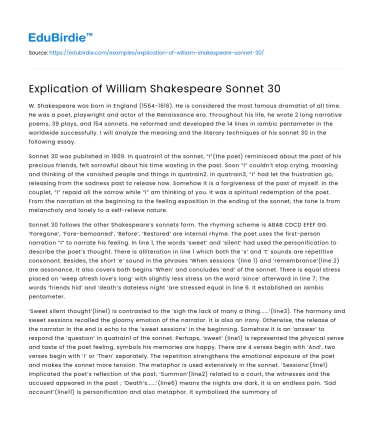W. Shakespeare was born in England (1564-1616). He is considered the most famous dramatist of all time. He was a poet, playwright and actor of the Renaissance era. Throughout his life, he wrote 2 long narrative poems, 39 plays, and 154 sonnets. He reformed and developed the 14 lines in iambic pentameter in the worldwide successfully. I will analyze the meaning and the literary techniques of his sonnet 30 in the following essay.
Sonnet 30 was published in 1609. In quatrain1 of the sonnet, “I”(the poet) reminisced about the past of his precious friends, felt sorrowful about his time wasting in the past. Soon “I” couldn’t stop crying, moaning and thinking of the vanished people and things in quatrain2. In quatrain3, “I” had let the frustration go, releasing from the sadness past to release now. Somehow it is a forgiveness of the past of myself. In the couplet, “I” repaid all the sorrow while “I” am thinking of you. It was a spiritual redemption of the poet. From the narration at the beginning to the feeling exposition in the ending of the sonnet, the tone is from melancholy and lonely to a self-relieve nature.
Save your time!
We can take care of your essay
- Proper editing and formatting
- Free revision, title page, and bibliography
- Flexible prices and money-back guarantee
Sonnet 30 follows the other Shakespeare’s sonnets form. The rhyming scheme is ABAB CDCD EFEF GG. ‘Foregone’, ‘Fore-bemoaned’, ‘Before’, ‘Restored’ are internal rhyme. The poet uses the first-person narration “I” to narrate his feeling. In line 1, the words ‘sweet’ and ‘silent’ had used the personification to describe the poet’s thought. There is alliteration in line 1 which both the ‘s’ and ‘t’ sounds are repetitive consonant. Besides, the short ‘e’ sound in the phrases ‘When sessions ‘(line 1) and ‘remembrance’(line 2) are assonance, it also covers both begins ‘When’ and concludes ‘end’ of the sonnet. There is equal stress placed on ‘weep afresh love’s long’ with slightly less stress on the word ‘since’ afterward in line 7; The words ‘friends hid’ and ‘death’s dateless night ’are stressed equal in line 6. It established an iambic pentameter.
‘Sweet silent thought’(line1) is contrasted to the ‘sigh the lack of many a thing......’(line3). The harmony and sweet sessions recalled the gloomy emotion of the narrator. It is also an irony. Otherwise, the release of the narrator in the end is echo to the ‘sweet sessions’ in the beginning. Somehow it is an ‘answer’ to respond the ‘question’ in quatrain1 of the sonnet. Perhaps, ‘sweet’ (line1) is represented the physical sense and taste of the poet feeling, symbols his memories are happy. There are 4 verses begin with ‘And’, two verses begin with ‘I’ or ‘Then’ separately. The repetition strengthens the emotional exposure of the poet and makes the sonnet more tension. The metaphor is used extensively in the sonnet. ‘Sessions’(line1) implicated the poet’s reflection of the past; ‘Summon’(line2) related to a court, the witnesses and the accused appeared in the past ; ‘Death’s......’(line6) means the nights are dark, it is an endless pain. ‘Sad account’(line11) is personification and also metaphor. It symbolized the summary of the poet’s lifelong losses.
Sonnet 30 is one of the most famous poems of W. Shakespeare. Apart from the flourishing of literary devices, its financial terms such as ‘account’, ‘pay’, ‘losses’, ‘restored’ etc. are borrowed from the world of accounts.
William Shakespeare Sonnet 30
When to the sessions of sweet silent thought,→ A
I summon up remembrance of things past,→ B
I sigh the lack of many a thing I sought, → A
And with old woes new wail my dear times' waste: → B
Then can I drown an eye, unused to flow, → C
For precious friends hid in death's dateless night, → D
And weep afresh love's long since cancell'd woe, → C
And moan the expense of many a vanish'd sight: → D
Then can I grieve at grievances foregone, → E
And heavily from woe to woe tell o'er→ F
The sad account of fore-bemoaned moan, → E
Which I new pay as if not paid before. → F
But if the while I think on thee, dear friend, → G
All losses are restor'd and sorrows end. → G
References
- Stephen Holliday Certified Educator. eNotes Editorial , 2019, https://www.enotes.com/homework-help/what-theme-sonnet-30-what-some-poetry-literary-311434. Accessed 20 Oct. 2019.
- 'Analysis of Shakespeare’s Sonnet 30.’. Paper Ap.com, 1 Jan 2018, https://paperap.com/paper-on-analysis-of-shakespeares-sonnet-30/. Accessed 20 Oct. 2019.
- Interesting Literature, 20 Mar 2017, https://interestingliterature.com/2017/03/20/a-short-analysis-of-shakespeares-sonnet-30-when-to-the-sessions-of-sweet-silent-thought/. Accessed 20 Oct. 2019.
- http://blog.sina.com.cn/s/blog_9dead0ec0102v0qv.html. Accessed 20 Oct. 2019.
- A Short Analysis of Shakespeare’s Sonnet 30: ‘When to the sessions of sweet silent thought’.






 Stuck on your essay?
Stuck on your essay?

